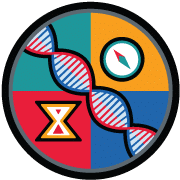Evolution of the Anglo Saxon Chronicle
Much of what we know and understand about the history of Britain in the Medieval Age is thanks to the chroniclers of the 12th century and 13th century, whose creative skills and aspirations as historical story tellers and recorders, were at their height.
Chronicle writing began with the production of the Anglo-Saxon Chronicle in the reign of King Alfred. It was begun in 892, with King Alfred influencing its production probably as part of his desire to raise literacy standards amongst those clerics whose lack of Latin and learning, he found totally unacceptable.
The Anglo Saxon Chronicles told the story of England, all be it written from a perspective of the Wessex dynasty.
-
- The Chronicle was sent out, probably from the Winchester Scriptorium, to the principle churches and monasteries of England and once in their hands, they added to the Chronicle every year.
- In this way therefore the evolution of the Chronicles becomes more convoluted as rather than being a homogeneous document, each monastery would write its own version of events.
What is completely fascinating though is that installments to be added to the Chronicle were sent out, to the churches and monasteries, from a central distribution point. They would then copy these into the Chronicle whilst at the same time adding their own content.
-
- King Alfred’s initial idea of a national chronicle, which would be continued annually, from generation to generation and from century to century, was adhered to by the Benedictine monks.
- The reason for them continuing with the Chronicles is open to conjecture but they did include in the Chronicle, a lot of their own history, about their monastery and their locality.
But how did the writing of the Chronicles survive the Norman invasion when the English language was no longer the language of literate people, the learned language was Latin, the language of the nobility was Norman French?
-
- Let us consider the Normans nobles, firstly they were the invading and therefore the Chronicle became the Anglo- Norman chronicler’s principal source for Anglo-Saxon history. Secondly, they were compulsive compilers of data, so, recording events in a chronological order and compiling their own story must have been compelling.
- In so as much as it was desperately important for the monasteries to record their own history, in particular the Benedictine monasteries, who were under threat from their new lords, so too it was important for England’s new Norman rulers. Both had to prove and establish their legacy.
- This was a great age of record keeping. The central government was proliferating documents and building up a vast archive and each monastery was doing the same thing on a smaller scale.
- The chronicle of a monastery became a record of national events and of government, both national and local.
The purpose of the Chronicle had evolved.
The authorship of nearly all the chronicles is unknown. What is known about them is apparent in their writing they wrote eloquently and at length in excellent Latin. They conveyed their own personalities through their writings often giving sharp, quick witted accounts of events.
Some though were outstanding, in particular those writing out of the Benedictine Monastery at St Alban’s.
- They either copied out earlier chronicles adding to them as they wrote or they ‘picked up’ where the earlier chronicler left off. In this way they take on the tone of story telling and it is debatable where the history ends and the story starts.
- Other chroniclers however, were contemporary to the period and not therefore written from an historic perspective. In these can be included the crusade chronicles.
‘The St. Alban’s Chronicles’ were hand written at the end of the 12th century. Three chroniclers stand out, Roger of Wendover in Buckinghamshire, 1170 – 1237. Matthew of Paris 1200 – 1259 and William of Rishanger ,1250 – 1320
A fourth chronicler was Roger of Howden, Yorkshire, 1150 – 1201, who, whilst being at St Alban’s was not a monk but in the employ of Henry II.
Between 1185 and 1190 he worked as Henry’s Justice of the Forest. He then went on crusade with Richard I and it was on his return that he writes his chronicles and through him is how we understand so much about the rule of Henry II.
-
- Roger of Howden’s chronicle begins in AD732 with the first 400 years being copied from earlier works. His own personal record covers from 1170 to 1201.
- Roger of Wendover added events from 1201 to 1235.
- Matthew Paris, probably the most literate and scholarly of the chroniclers, copied the earlier chronicle but added a lot of notes to Roger of Wendover’s section. He continued his own record from 1235 to 1259
- Finally William Rishanger added 1259 to 1307.
The Chronicles give historians an intriguing view of life, actual and perceived from a distance of nearly a thousand years. They tell if not exact historical truth, then a view of what was important to those ancestors of ours living in Medieval Britain. When read across a series of time-lined documents that do reveal some intriguing connections and are easily accessible online sources available for you to use.
Additional Anglo Saxon Resources you Can Explore Online
The following are available resources you can explore further, if you are interested in how these substantial documents can be more easily read and analysed directly for your own research projects and historical areas of interest, then also take a look at Intriguing Family History for a series of articles on how tools for digital humanities research (to be published by early September) can help us harvest great source material from these vast bodies of historical texts that are gradually being made more accessible and online.
- The Anglo Saxon Chronicles Online Translation
- Yale Law School Translations
- Anglo Saxon Chronicles Gutenberg Project Free Ebook downloads in various versions (ebook publishing file formats)



